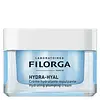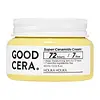What's inside
What's inside
 Key Ingredients
Key Ingredients

 Benefits
Benefits

 Concerns
Concerns

 Ingredients Side-by-side
Ingredients Side-by-side

Water
Skin ConditioningPropylheptyl Caprylate
EmollientGlycerin
HumectantButylene Glycol
HumectantHydroxyethyl Acrylate/Sodium Acryloyldimethyl Taurate Copolymer
Emulsion StabilisingC15-19 Alkane
SolventDicaprylyl Carbonate
EmollientSucrose Palmitate
Emollient1,2-Hexanediol
Skin ConditioningCI 77163
Cosmetic ColorantHydrolyzed Sodium Hyaluronate
Skin ConditioningParfum
MaskingSilica
AbrasiveCarbomer
Emulsion StabilisingSodium Benzoate
MaskingGlyceryl Linoleate
EmollientTocopheryl Acetate
AntioxidantLevulinic Acid
PerfumingSodium Hyaluronate
HumectantXanthan Gum
EmulsifyingPolysorbate 60
EmulsifyingSorbitan Isostearate
EmulsifyingSodium Levulinate
Skin ConditioningStearalkonium Hectorite
Gel FormingSodium Hydroxide
BufferingBiosaccharide Gum-1
HumectantSodium Phytate
Adenosine
Skin ConditioningBenzyl Alcohol
PerfumingPentylene Glycol
Skin ConditioningPropylene Carbonate
SolventSodium Hyaluronate Crosspolymer
HumectantGlyceryl Caprylate
EmollientCitric Acid
BufferingPotassium Sorbate
PreservativePrunus Amygdalus Dulcis Oil
Skin ConditioningSodium Chloride
MaskingP-Anisic Acid
MaskingTocopherol
AntioxidantGlucose
HumectantPhenoxyethanol
PreservativePotassium Chloride
Calcium Chloride
AstringentMagnesium Sulfate
Glutamine
Skin ConditioningSodium Phosphate
BufferingAscorbic Acid
AntioxidantSodium Acetate
BufferingLysine Hcl
Skin ConditioningArginine Hcl
Skin ConditioningAlanine
MaskingHistidine Hcl
Skin ConditioningValine
MaskingLeucine
Skin ConditioningThreonine
Isoleucine
Skin ConditioningTryptophan
MaskingPhenylalanine
MaskingTyrosine
MaskingGlycine
BufferingPolysorbate 80
EmulsifyingSerine
MaskingCystine
MaskingCyanocobalamin
Skin ConditioningGlutathione
Asparagine
MaskingAspartic Acid
MaskingOrnithine Hcl
Skin ConditioningGlutamic Acid
HumectantNicotinamide Adenine Dinucleotide
Skin ConditioningProline
Skin ConditioningMethionine
Skin ConditioningTaurine
BufferingHydroxyproline
Skin ConditioningGlucosamine Hcl
Coenzyme A
Skin ConditioningSodium Glucuronate
HumectantThiamine Diphosphate
Skin ConditioningRetinyl Acetate
Skin ConditioningInositol
HumectantNiacin
SmoothingNiacinamide
SmoothingPyridoxine Hcl
Skin ConditioningBiotin
AntiseborrhoeicCalcium Pantothenate
Riboflavin
Cosmetic ColorantSodium Tocopheryl Phosphate
AntioxidantThiamine Hcl
MaskingFolic Acid
Skin ConditioningWater, Propylheptyl Caprylate, Glycerin, Butylene Glycol, Hydroxyethyl Acrylate/Sodium Acryloyldimethyl Taurate Copolymer, C15-19 Alkane, Dicaprylyl Carbonate, Sucrose Palmitate, 1,2-Hexanediol, CI 77163, Hydrolyzed Sodium Hyaluronate, Parfum, Silica, Carbomer, Sodium Benzoate, Glyceryl Linoleate, Tocopheryl Acetate, Levulinic Acid, Sodium Hyaluronate, Xanthan Gum, Polysorbate 60, Sorbitan Isostearate, Sodium Levulinate, Stearalkonium Hectorite, Sodium Hydroxide, Biosaccharide Gum-1, Sodium Phytate, Adenosine, Benzyl Alcohol, Pentylene Glycol, Propylene Carbonate, Sodium Hyaluronate Crosspolymer, Glyceryl Caprylate, Citric Acid, Potassium Sorbate, Prunus Amygdalus Dulcis Oil, Sodium Chloride, P-Anisic Acid, Tocopherol, Glucose, Phenoxyethanol, Potassium Chloride, Calcium Chloride, Magnesium Sulfate, Glutamine, Sodium Phosphate, Ascorbic Acid, Sodium Acetate, Lysine Hcl, Arginine Hcl, Alanine, Histidine Hcl, Valine, Leucine, Threonine, Isoleucine, Tryptophan, Phenylalanine, Tyrosine, Glycine, Polysorbate 80, Serine, Cystine, Cyanocobalamin, Glutathione, Asparagine, Aspartic Acid, Ornithine Hcl, Glutamic Acid, Nicotinamide Adenine Dinucleotide, Proline, Methionine, Taurine, Hydroxyproline, Glucosamine Hcl, Coenzyme A, Sodium Glucuronate, Thiamine Diphosphate, Retinyl Acetate, Inositol, Niacin, Niacinamide, Pyridoxine Hcl, Biotin, Calcium Pantothenate, Riboflavin, Sodium Tocopheryl Phosphate, Thiamine Hcl, Folic Acid
Water
Skin ConditioningButylene Glycol
HumectantGlycerin
HumectantCyclopentasiloxane
EmollientButylene Glycol Dicaprylate/Dicaprate
EmollientEthylhexyl Isononanoate
EmollientHydrogenated Polyisobutene
EmollientGlyceryl Stearate
Emollient1,2-Hexanediol
Skin ConditioningCetearyl Alcohol
EmollientStearic Acid
CleansingPolysorbate 60
EmulsifyingPolyglyceryl-3 Methylglucose Distearate
EmulsifyingPentaerythrityl Tetraethylhexanoate
EmollientStearyl Behenate
EmollientDimethicone
EmollientDimethicone/Vinyl Dimethicone Crosspolymer
Skin ConditioningCetearyl Glucoside
EmulsifyingPhytosteryl/Isostearyl/Cetyl/Stearyl/Behenyl Dimer Dilinoleate
Skin ConditioningCeramide NP
Skin ConditioningHydrogenated Polydecene
EmollientButyrospermum Parkii Butter
Skin ConditioningCeteareth-20
CleansingGlyceryl Citrate/Lactate/Linoleate/Oleate
EmulsifyingHydroxypropyl Bispalmitamide Mea
EmollientGlycosphingolipids
EmollientCeramide AP
Skin ConditioningMeadowfoam Estolide
Skin ConditioningGlycine Soja Sterols
EmollientCaprylic/Capric Triglyceride
MaskingCeramide EOP
Skin ConditioningGlyceryl Polymethacrylate
Aleuritic Acid
Skin ConditioningYeast Extract
Skin ConditioningGlycoproteins
Skin ConditioningBetaine
HumectantSodium Hyaluronate
HumectantPolyquaternium-51
Skin ConditioningCocos Nucifera Oil
MaskingAloe Barbadensis Leaf Extract
EmollientHydroxyethyl Acrylate/Sodium Acryloyldimethyl Taurate Copolymer
Emulsion StabilisingSqualane
EmollientCarbomer
Emulsion StabilisingTromethamine
BufferingTocopheryl Acetate
AntioxidantGlycerylamidoethyl Methacrylate/Stearyl Methacrylate Copolymer
HumectantAlteromonas Ferment Extract
Skin ConditioningBacillus Ferment
Skin ConditioningPropylene Glycol
HumectantTheobroma Cacao Seed Extract
AntioxidantDipropylene Glycol
HumectantLavandula Angustifolia Oil
MaskingCitrus Grandis Peel Oil
MaskingCymbopogon Citratus Leaf Oil
MaskingPelargonium Graveolens Oil
MaskingCitrus Aurantium Dulcis Peel Oil
MaskingPogostemon Cablin Leaf Oil
MaskingSantalum Album Oil
MaskingChamomilla Recutita Flower Oil
MaskingNiacinamide
SmoothingAllantoin
Skin ConditioningDisodium EDTA
Ethylhexylglycerin
Skin ConditioningWater, Butylene Glycol, Glycerin, Cyclopentasiloxane, Butylene Glycol Dicaprylate/Dicaprate, Ethylhexyl Isononanoate, Hydrogenated Polyisobutene, Glyceryl Stearate, 1,2-Hexanediol, Cetearyl Alcohol, Stearic Acid, Polysorbate 60, Polyglyceryl-3 Methylglucose Distearate, Pentaerythrityl Tetraethylhexanoate, Stearyl Behenate, Dimethicone, Dimethicone/Vinyl Dimethicone Crosspolymer, Cetearyl Glucoside, Phytosteryl/Isostearyl/Cetyl/Stearyl/Behenyl Dimer Dilinoleate, Ceramide NP, Hydrogenated Polydecene, Butyrospermum Parkii Butter, Ceteareth-20, Glyceryl Citrate/Lactate/Linoleate/Oleate, Hydroxypropyl Bispalmitamide Mea, Glycosphingolipids, Ceramide AP, Meadowfoam Estolide, Glycine Soja Sterols, Caprylic/Capric Triglyceride, Ceramide EOP, Glyceryl Polymethacrylate, Aleuritic Acid, Yeast Extract, Glycoproteins, Betaine, Sodium Hyaluronate, Polyquaternium-51, Cocos Nucifera Oil, Aloe Barbadensis Leaf Extract, Hydroxyethyl Acrylate/Sodium Acryloyldimethyl Taurate Copolymer, Squalane, Carbomer, Tromethamine, Tocopheryl Acetate, Glycerylamidoethyl Methacrylate/Stearyl Methacrylate Copolymer, Alteromonas Ferment Extract, Bacillus Ferment, Propylene Glycol, Theobroma Cacao Seed Extract, Dipropylene Glycol, Lavandula Angustifolia Oil, Citrus Grandis Peel Oil, Cymbopogon Citratus Leaf Oil, Pelargonium Graveolens Oil, Citrus Aurantium Dulcis Peel Oil, Pogostemon Cablin Leaf Oil, Santalum Album Oil, Chamomilla Recutita Flower Oil, Niacinamide, Allantoin, Disodium EDTA, Ethylhexylglycerin
 Reviews
Reviews

Ingredients Explained
These ingredients are found in both products.
Ingredients higher up in an ingredient list are typically present in a larger amount.
1,2-Hexanediol is a synthetic liquid and another multi-functional powerhouse.
It is a:
- Humectant, drawing moisture into the skin
- Emollient, helping to soften skin
- Solvent, dispersing and stabilizing formulas
- Preservative booster, enhancing the antimicrobial activity of other preservatives
Butylene Glycol (or BG) is used within cosmetic products for a few different reasons:
Overall, Butylene Glycol is a safe and well-rounded ingredient that works well with other ingredients.
Though this ingredient works well with most skin types, some people with sensitive skin may experience a reaction such as allergic rashes, closed comedones, or itchiness.
Learn more about Butylene GlycolCarbomer is a polymer of acrylic acid. Its main role is to create a gel consistency.
A high amount of carbomer can cause pilling or balling up of products. Don't worry, most products contain 1% or less of carbomer.
Glycerin is already naturally found in your skin. It helps moisturize and protect your skin.
A study from 2016 found glycerin to be more effective as a humectant than AHAs and hyaluronic acid.
As a humectant, it helps the skin stay hydrated by pulling moisture to your skin. The low molecular weight of glycerin allows it to pull moisture into the deeper layers of your skin.
Hydrated skin improves your skin barrier; Your skin barrier helps protect against irritants and bacteria.
Glycerin has also been found to have antimicrobial and antiviral properties. Due to these properties, glycerin is often used in wound and burn treatments.
In cosmetics, glycerin is usually derived from plants such as soybean or palm. However, it can also be sourced from animals, such as tallow or animal fat.
This ingredient is organic, colorless, odorless, and non-toxic.
Glycerin is the name for this ingredient in American English. British English uses Glycerol/Glycerine.
Learn more about GlycerinThis is a synthetic polymer. It helps improve the texture of products by adding thickness and gel-like feel.
It is also an emulsifer, meaning it prevents ingredients such as oil and water from separating. It also helps evenly disperse other ingredients.
Niacinamide is a multitasking form of vitamin B3 that strengthens the skin barrier, reduces pores and dark spots, regulates oil, and improves signs of aging.
And the best part? It's gentle and well-tolerated by most skin types, including sensitive and reactive skin.
You might have heard of "niacin flush", or the reddening of skin that causes itchiness. Niacinamide has not been found to cause this.
In very rare cases, some individuals may not be able to tolerate niacinamide at all or experience an allergic reaction to it.
If you are experiencing flaking, irritation, and dryness with this ingredient, be sure to double check all your products as this ingredient can be found in all categories of skincare.
When incorporating niacinamide into your routine, look out for concentration amounts. Typically, 5% niacinamide provides benefits such as fading dark spots. However, if you have sensitive skin, it is better to begin with a smaller concentration.
When you apply niacinamide to your skin, your body converts it into nicotinamide adenine dinucleotide (NAD). NAD is an essential coenzyme that is already found in your cells as "fuel" and powers countless biological processes.
In your skin, NAD helps repair cell damage, produce new healthy cells, support collagen production, strengthen the skin barrier, and fight environmental stressors (like UV and pollution).
Our natural NAD levels start to decline with age, leading to slower skin repair, visible aging, and a weaker skin barrier. By providing your skin niacinamide, you're recharging your skin's NAD levels. This leads to stronger, healthier, and younger looking skin.
Another name for vitamin B3 is nicotinamide. This vitamin is water-soluble and our bodies don't store it. We obtain Vitamin B3 from either food or skincare. Meat, fish, wheat, yeast, and leafy greens contain vitamin B3.
The type of niacinamide used in skincare is synthetically created.
Learn more about NiacinamidePolysorbate 60 is used to help stabilize products. It is a surfactant and emulsifier. These properties help keep ingredients together in a product. Surfactants help reduce surface tension between ingredients with different states, such as liquids and solids. Emulsifiers help prevent oils and waters from separating.
Polysorbate 60 is sorbitol-based and created from the ethoxylation of sorbitan. Ethoxylation is a chemical reaction used to add ethylene oxide. Sorbitan is a the dehydrated version of sorbitol, a sugar found in fruits.
In this case, the 60 comes from reacting 60 units of ethylene oxide with sorbitan.
Polysorbates are commonly used in medicine and foods.
Learn more about Polysorbate 60Sodium Hyaluronate is hyaluronic acid's salt form. It is commonly derived from the sodium salt of hyaluronic acid.
Like hyaluronic acid, it is great at holding water and acts as a humectant. This makes it a great skin hydrating ingredient.
Sodium Hyaluronate is naturally occurring in our bodies and is mostly found in eye fluid and joints.
These are some other common types of Hyaluronic Acid:
Learn more about Sodium HyaluronateTocopheryl Acetate is AKA Vitamin E. It is an antioxidant and protects your skin from free radicals. Free radicals damage the skin by breaking down collagen.
One study found using Tocopheryl Acetate with Vitamin C decreased the number of sunburned cells.
Tocopheryl Acetate is commonly found in both skincare and dietary supplements.
Learn more about Tocopheryl AcetateWater. It's the most common cosmetic ingredient of all. You'll usually see it at the top of ingredient lists, meaning that it makes up the largest part of the product.
So why is it so popular? Water most often acts as a solvent - this means that it helps dissolve other ingredients into the formulation.
You'll also recognize water as that liquid we all need to stay alive. If you see this, drink a glass of water. Stay hydrated!
Learn more about Water